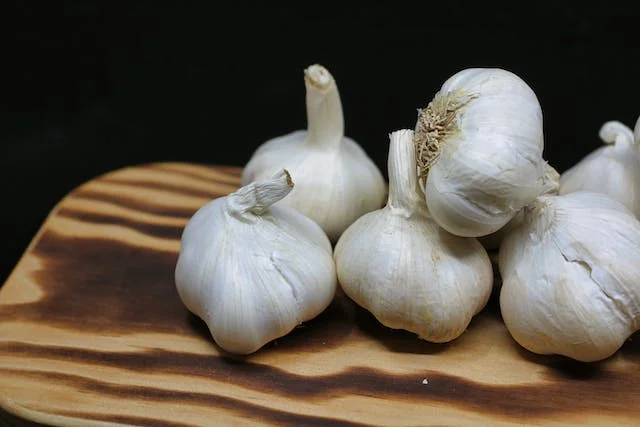How to Make Garlic Juice?

Garlic juice is a potent elixir extracted from fresh garlic cloves, known for its intense flavor and numerous health benefits. Packed with allicin, antioxidants, and essential nutrients, garlic juice has gained popularity as a natural remedy and culinary enhancement.
Garlic juice is a concentrated form of garlic flavor, making it a convenient addition to various culinary dishes. It can be used in marinades, dressings, sauces, soups, and more.
In this article, we will guide you through the step-by-step process of making Garlic Juice in your kitchen.
Table of Contents
Ingredients
- Fresh garlic bulbs
- Water
- Lemon (optional, for flavor)
- Honey (optional, for sweetness)
- A blender
- Cheesecloth or fine mesh strainer
- Glass jars or bottles for storage
How to Make Garlic Juice?
Making garlic juice is a simple process that you can do at home. Garlic is known for its potential health benefits, including its antimicrobial properties.
By following the simple steps, you can create your garlic juice at home and explore its potential to enhance both your culinary creations and overall well-being.
1. Gather Fresh Garlic Bulbs
Start by selecting fresh and firm garlic bulbs. Choose organic garlic if possible, as it tends to have a more robust flavor and may contain higher levels of beneficial compounds.

2. Peel and Clean the Garlic
Peel the garlic cloves and ensure they are free from any dirt or debris. Rinse the cloves under cold water to remove excess dirt.
3. Chop the Garlic
Chop the peeled garlic cloves into smaller pieces. This will facilitate the blending process and ensure a smoother consistency in the juice.

4. Blend the Garlic
Place the chopped garlic cloves in a blender. Add water in a ratio of 1:2 (one part garlic to two parts water). Blend until you achieve a smooth and uniform mixture.
5. Strain the Mixture
To extract the juice, place a cheesecloth or fine mesh strainer over a bowl or jar. Pour the blended garlic mixture through the strainer, pressing down on the solids with a spoon to extract as much liquid as possible.
6. Optional Additions
For added flavor and health benefits, consider adding a splash of fresh lemon juice for acidity or a dollop of honey for sweetness. Stir the mixture well to combine these optional ingredients.
7. Store the Garlic Juice
Transfer the garlic juice into glass jars or bottles with tight-sealing lids. Store in the refrigerator to maintain freshness. Properly stored, garlic juice can last for up to a week.
Health Benefits of Garlic Juice
Garlic juice, derived from the pungent and flavorful garlic cloves, offers a wide array of health benefits. From immune system support to cardiovascular health, the compounds found in garlic contribute to its medicinal properties.
Here are some key health benefits of incorporating garlic juice into your diet:
1. Immune System Boost
Garlic Juice is renowned for its immune-boosting properties. It contains allicin, a sulfur-containing compound with antimicrobial and antiviral effects. Regular consumption of garlic juice may help strengthen the immune system, making the body more resilient to infections and illnesses.
2. Cardiovascular Health
Studies suggest that garlic may have positive effects on cardiovascular health. It is believed to help lower blood pressure and reduce cholesterol levels. Allicin, along with other sulfur compounds in garlic, may contribute to improved heart health by promoting better blood flow and reducing the risk of atherosclerosis.
3. Anti-Inflammatory Effects
Allicin, the key bioactive compound in garlic, exhibits anti-inflammatory properties. Chronic inflammation is associated with various health conditions, including cardiovascular diseases and arthritis. Regular consumption of garlic juice may contribute to mitigating inflammation and promoting better overall health.
4. Respiratory Health:
Garlic has natural antimicrobial properties that may benefit respiratory health. It is often used to alleviate symptoms of colds and flu. The expectorant properties of garlic may help relieve congestion and promote respiratory comfort.
5. Regulation of Blood Sugar Levels
Some studies suggest that garlic may help regulate blood sugar levels, making it potentially beneficial for individuals with diabetes or those at risk of developing the condition. Including garlic juice in a balanced diet may contribute to better blood sugar control.
6. Anti-Cancer Potential
While research is ongoing, certain studies suggest that garlic may have anti-cancer properties. Allicin and other bioactive compounds in garlic may inhibit the growth of cancer cells and reduce the risk of certain types of cancer, particularly in the digestive system.
7. Joint Health
Garlic’s anti-inflammatory properties may also extend to joint health. Individuals with inflammatory joint conditions, such as arthritis, may experience relief from incorporating garlic juice into their diet due to its potential to reduce inflammation.
Conclusion
Making garlic juice at home is a simple and rewarding process that allows you to harness the full potential of this potent ingredient. Whether you’re seeking to boost your immune system, promote heart health, or simply add a burst of flavor to your meals, garlic juice is a versatile and nutritious addition to your daily regimen. Experiment with different ratios and optional ingredients to find the perfect blend that suits your taste buds and health goals.